Prioritization of Complex Patient Health Issues: Medical Nursing
VerifiedAdded on 2023/03/31
|8
|1871
|488
Report
AI Summary
This report analyzes a case study of a 69-year-old male patient, Danial, admitted to the respiratory medical unit with a week-long history of cough and shortness of breath. The assignment identifies five key health issues within the nurses' scope of practice: COPD, pneumonia, hypercholesterolemia, dehydration, and paleness. It then prioritizes the top three issues as COPD, pneumonia, and hypercholesterolemia, providing a detailed rationale for the ranking based on the A-G assessment algorithm and relevant literature. The report outlines the nurses' responsibilities in addressing these priority issues through assessment, care coordination, and care provision, while also connecting these responsibilities to nursing regulatory frameworks such as the Registered Nurses Standards for Practice, NSW health policy, and National Safety and Quality Health Service Standards. The report emphasizes the importance of early intervention and patient education in managing the patient's complex health needs.
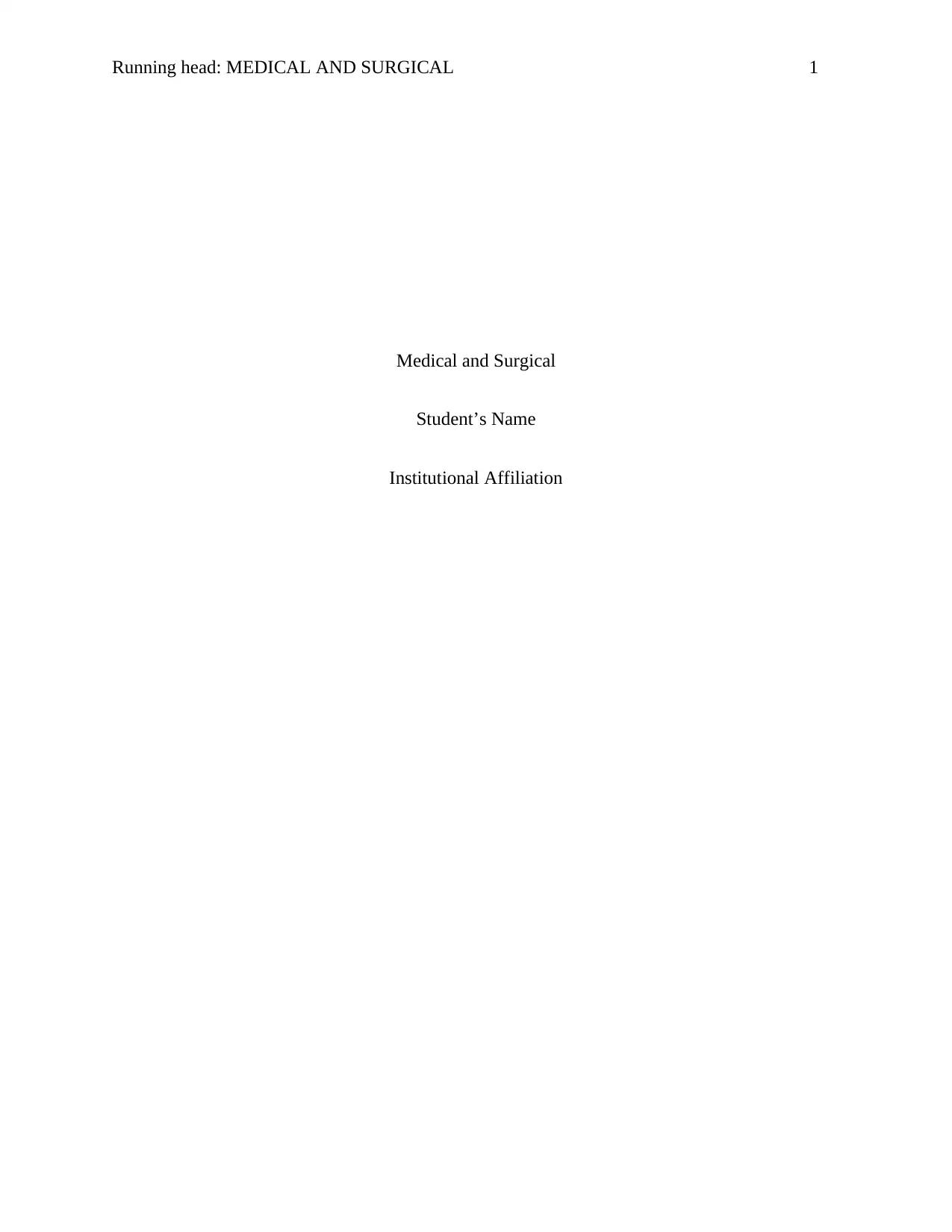
Running head: MEDICAL AND SURGICAL 1
Medical and Surgical
Student’s Name
Institutional Affiliation
Medical and Surgical
Student’s Name
Institutional Affiliation
Paraphrase This Document
Need a fresh take? Get an instant paraphrase of this document with our AI Paraphraser
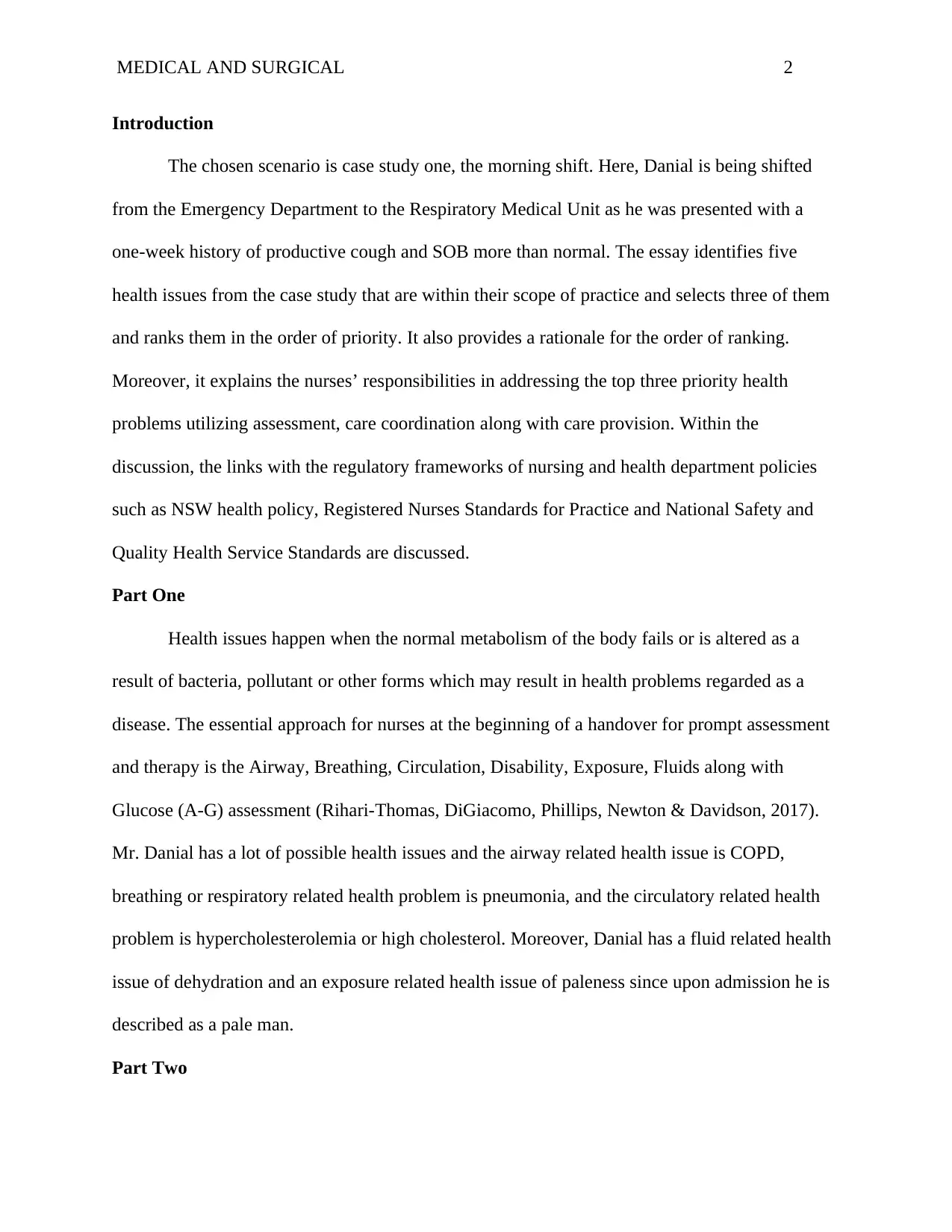
MEDICAL AND SURGICAL 2
Introduction
The chosen scenario is case study one, the morning shift. Here, Danial is being shifted
from the Emergency Department to the Respiratory Medical Unit as he was presented with a
one-week history of productive cough and SOB more than normal. The essay identifies five
health issues from the case study that are within their scope of practice and selects three of them
and ranks them in the order of priority. It also provides a rationale for the order of ranking.
Moreover, it explains the nurses’ responsibilities in addressing the top three priority health
problems utilizing assessment, care coordination along with care provision. Within the
discussion, the links with the regulatory frameworks of nursing and health department policies
such as NSW health policy, Registered Nurses Standards for Practice and National Safety and
Quality Health Service Standards are discussed.
Part One
Health issues happen when the normal metabolism of the body fails or is altered as a
result of bacteria, pollutant or other forms which may result in health problems regarded as a
disease. The essential approach for nurses at the beginning of a handover for prompt assessment
and therapy is the Airway, Breathing, Circulation, Disability, Exposure, Fluids along with
Glucose (A-G) assessment (Rihari-Thomas, DiGiacomo, Phillips, Newton & Davidson, 2017).
Mr. Danial has a lot of possible health issues and the airway related health issue is COPD,
breathing or respiratory related health problem is pneumonia, and the circulatory related health
problem is hypercholesterolemia or high cholesterol. Moreover, Danial has a fluid related health
issue of dehydration and an exposure related health issue of paleness since upon admission he is
described as a pale man.
Part Two
Introduction
The chosen scenario is case study one, the morning shift. Here, Danial is being shifted
from the Emergency Department to the Respiratory Medical Unit as he was presented with a
one-week history of productive cough and SOB more than normal. The essay identifies five
health issues from the case study that are within their scope of practice and selects three of them
and ranks them in the order of priority. It also provides a rationale for the order of ranking.
Moreover, it explains the nurses’ responsibilities in addressing the top three priority health
problems utilizing assessment, care coordination along with care provision. Within the
discussion, the links with the regulatory frameworks of nursing and health department policies
such as NSW health policy, Registered Nurses Standards for Practice and National Safety and
Quality Health Service Standards are discussed.
Part One
Health issues happen when the normal metabolism of the body fails or is altered as a
result of bacteria, pollutant or other forms which may result in health problems regarded as a
disease. The essential approach for nurses at the beginning of a handover for prompt assessment
and therapy is the Airway, Breathing, Circulation, Disability, Exposure, Fluids along with
Glucose (A-G) assessment (Rihari-Thomas, DiGiacomo, Phillips, Newton & Davidson, 2017).
Mr. Danial has a lot of possible health issues and the airway related health issue is COPD,
breathing or respiratory related health problem is pneumonia, and the circulatory related health
problem is hypercholesterolemia or high cholesterol. Moreover, Danial has a fluid related health
issue of dehydration and an exposure related health issue of paleness since upon admission he is
described as a pale man.
Part Two
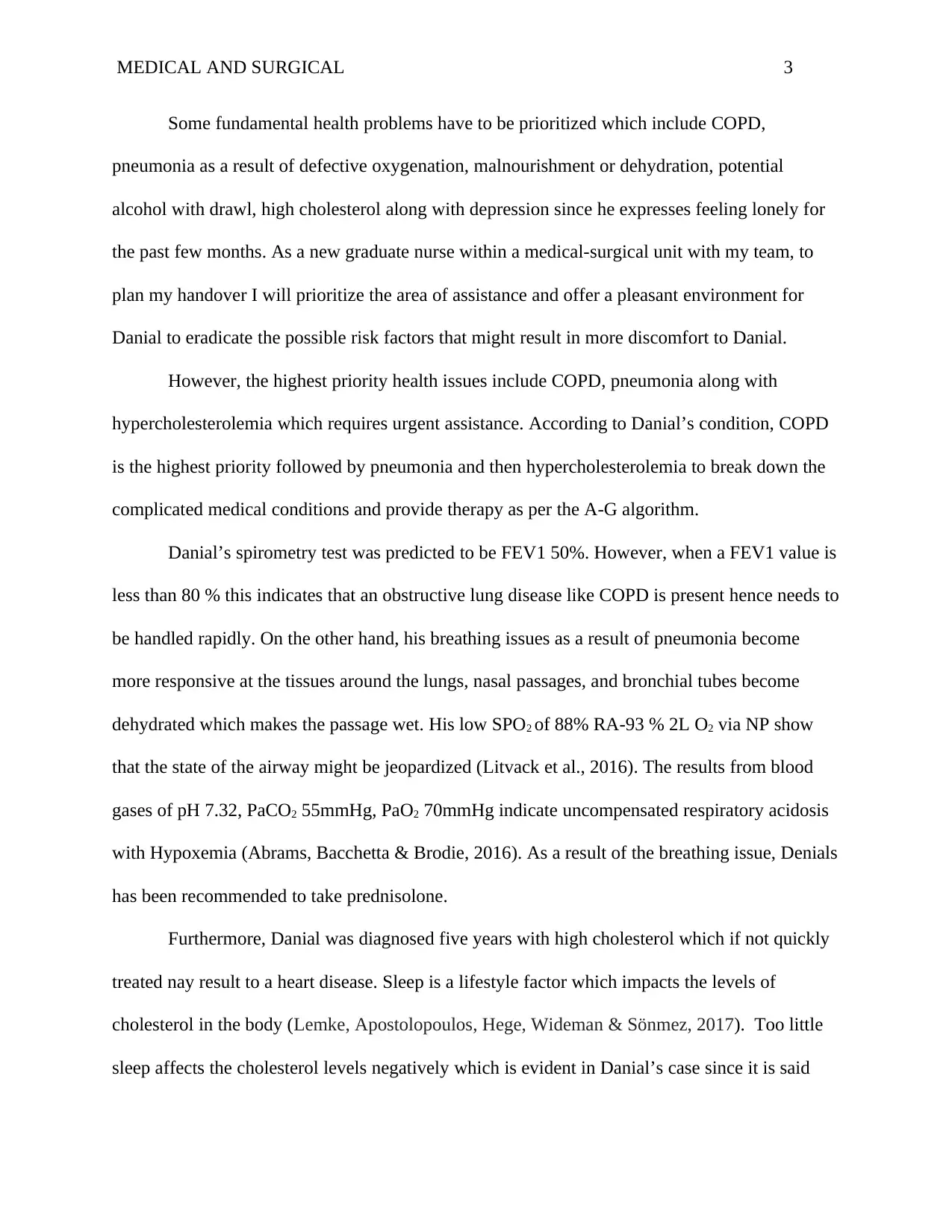
MEDICAL AND SURGICAL 3
Some fundamental health problems have to be prioritized which include COPD,
pneumonia as a result of defective oxygenation, malnourishment or dehydration, potential
alcohol with drawl, high cholesterol along with depression since he expresses feeling lonely for
the past few months. As a new graduate nurse within a medical-surgical unit with my team, to
plan my handover I will prioritize the area of assistance and offer a pleasant environment for
Danial to eradicate the possible risk factors that might result in more discomfort to Danial.
However, the highest priority health issues include COPD, pneumonia along with
hypercholesterolemia which requires urgent assistance. According to Danial’s condition, COPD
is the highest priority followed by pneumonia and then hypercholesterolemia to break down the
complicated medical conditions and provide therapy as per the A-G algorithm.
Danial’s spirometry test was predicted to be FEV1 50%. However, when a FEV1 value is
less than 80 % this indicates that an obstructive lung disease like COPD is present hence needs to
be handled rapidly. On the other hand, his breathing issues as a result of pneumonia become
more responsive at the tissues around the lungs, nasal passages, and bronchial tubes become
dehydrated which makes the passage wet. His low SPO2 of 88% RA-93 % 2L O2 via NP show
that the state of the airway might be jeopardized (Litvack et al., 2016). The results from blood
gases of pH 7.32, PaCO2 55mmHg, PaO2 70mmHg indicate uncompensated respiratory acidosis
with Hypoxemia (Abrams, Bacchetta & Brodie, 2016). As a result of the breathing issue, Denials
has been recommended to take prednisolone.
Furthermore, Danial was diagnosed five years with high cholesterol which if not quickly
treated nay result to a heart disease. Sleep is a lifestyle factor which impacts the levels of
cholesterol in the body (Lemke, Apostolopoulos, Hege, Wideman & Sönmez, 2017). Too little
sleep affects the cholesterol levels negatively which is evident in Danial’s case since it is said
Some fundamental health problems have to be prioritized which include COPD,
pneumonia as a result of defective oxygenation, malnourishment or dehydration, potential
alcohol with drawl, high cholesterol along with depression since he expresses feeling lonely for
the past few months. As a new graduate nurse within a medical-surgical unit with my team, to
plan my handover I will prioritize the area of assistance and offer a pleasant environment for
Danial to eradicate the possible risk factors that might result in more discomfort to Danial.
However, the highest priority health issues include COPD, pneumonia along with
hypercholesterolemia which requires urgent assistance. According to Danial’s condition, COPD
is the highest priority followed by pneumonia and then hypercholesterolemia to break down the
complicated medical conditions and provide therapy as per the A-G algorithm.
Danial’s spirometry test was predicted to be FEV1 50%. However, when a FEV1 value is
less than 80 % this indicates that an obstructive lung disease like COPD is present hence needs to
be handled rapidly. On the other hand, his breathing issues as a result of pneumonia become
more responsive at the tissues around the lungs, nasal passages, and bronchial tubes become
dehydrated which makes the passage wet. His low SPO2 of 88% RA-93 % 2L O2 via NP show
that the state of the airway might be jeopardized (Litvack et al., 2016). The results from blood
gases of pH 7.32, PaCO2 55mmHg, PaO2 70mmHg indicate uncompensated respiratory acidosis
with Hypoxemia (Abrams, Bacchetta & Brodie, 2016). As a result of the breathing issue, Denials
has been recommended to take prednisolone.
Furthermore, Danial was diagnosed five years with high cholesterol which if not quickly
treated nay result to a heart disease. Sleep is a lifestyle factor which impacts the levels of
cholesterol in the body (Lemke, Apostolopoulos, Hege, Wideman & Sönmez, 2017). Too little
sleep affects the cholesterol levels negatively which is evident in Danial’s case since it is said
⊘ This is a preview!⊘
Do you want full access?
Subscribe today to unlock all pages.

Trusted by 1+ million students worldwide
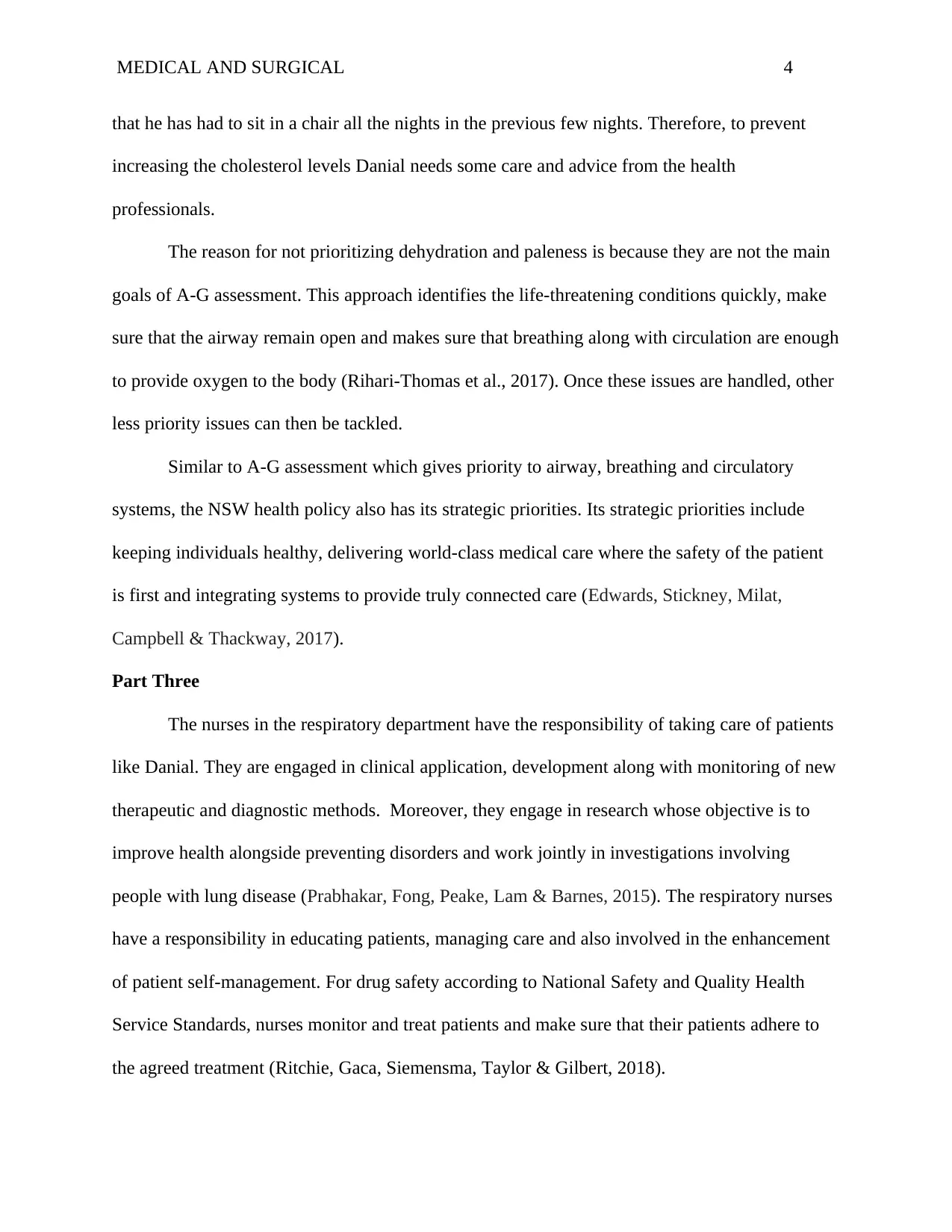
MEDICAL AND SURGICAL 4
that he has had to sit in a chair all the nights in the previous few nights. Therefore, to prevent
increasing the cholesterol levels Danial needs some care and advice from the health
professionals.
The reason for not prioritizing dehydration and paleness is because they are not the main
goals of A-G assessment. This approach identifies the life-threatening conditions quickly, make
sure that the airway remain open and makes sure that breathing along with circulation are enough
to provide oxygen to the body (Rihari-Thomas et al., 2017). Once these issues are handled, other
less priority issues can then be tackled.
Similar to A-G assessment which gives priority to airway, breathing and circulatory
systems, the NSW health policy also has its strategic priorities. Its strategic priorities include
keeping individuals healthy, delivering world-class medical care where the safety of the patient
is first and integrating systems to provide truly connected care (Edwards, Stickney, Milat,
Campbell & Thackway, 2017).
Part Three
The nurses in the respiratory department have the responsibility of taking care of patients
like Danial. They are engaged in clinical application, development along with monitoring of new
therapeutic and diagnostic methods. Moreover, they engage in research whose objective is to
improve health alongside preventing disorders and work jointly in investigations involving
people with lung disease (Prabhakar, Fong, Peake, Lam & Barnes, 2015). The respiratory nurses
have a responsibility in educating patients, managing care and also involved in the enhancement
of patient self-management. For drug safety according to National Safety and Quality Health
Service Standards, nurses monitor and treat patients and make sure that their patients adhere to
the agreed treatment (Ritchie, Gaca, Siemensma, Taylor & Gilbert, 2018).
that he has had to sit in a chair all the nights in the previous few nights. Therefore, to prevent
increasing the cholesterol levels Danial needs some care and advice from the health
professionals.
The reason for not prioritizing dehydration and paleness is because they are not the main
goals of A-G assessment. This approach identifies the life-threatening conditions quickly, make
sure that the airway remain open and makes sure that breathing along with circulation are enough
to provide oxygen to the body (Rihari-Thomas et al., 2017). Once these issues are handled, other
less priority issues can then be tackled.
Similar to A-G assessment which gives priority to airway, breathing and circulatory
systems, the NSW health policy also has its strategic priorities. Its strategic priorities include
keeping individuals healthy, delivering world-class medical care where the safety of the patient
is first and integrating systems to provide truly connected care (Edwards, Stickney, Milat,
Campbell & Thackway, 2017).
Part Three
The nurses in the respiratory department have the responsibility of taking care of patients
like Danial. They are engaged in clinical application, development along with monitoring of new
therapeutic and diagnostic methods. Moreover, they engage in research whose objective is to
improve health alongside preventing disorders and work jointly in investigations involving
people with lung disease (Prabhakar, Fong, Peake, Lam & Barnes, 2015). The respiratory nurses
have a responsibility in educating patients, managing care and also involved in the enhancement
of patient self-management. For drug safety according to National Safety and Quality Health
Service Standards, nurses monitor and treat patients and make sure that their patients adhere to
the agreed treatment (Ritchie, Gaca, Siemensma, Taylor & Gilbert, 2018).
Paraphrase This Document
Need a fresh take? Get an instant paraphrase of this document with our AI Paraphraser
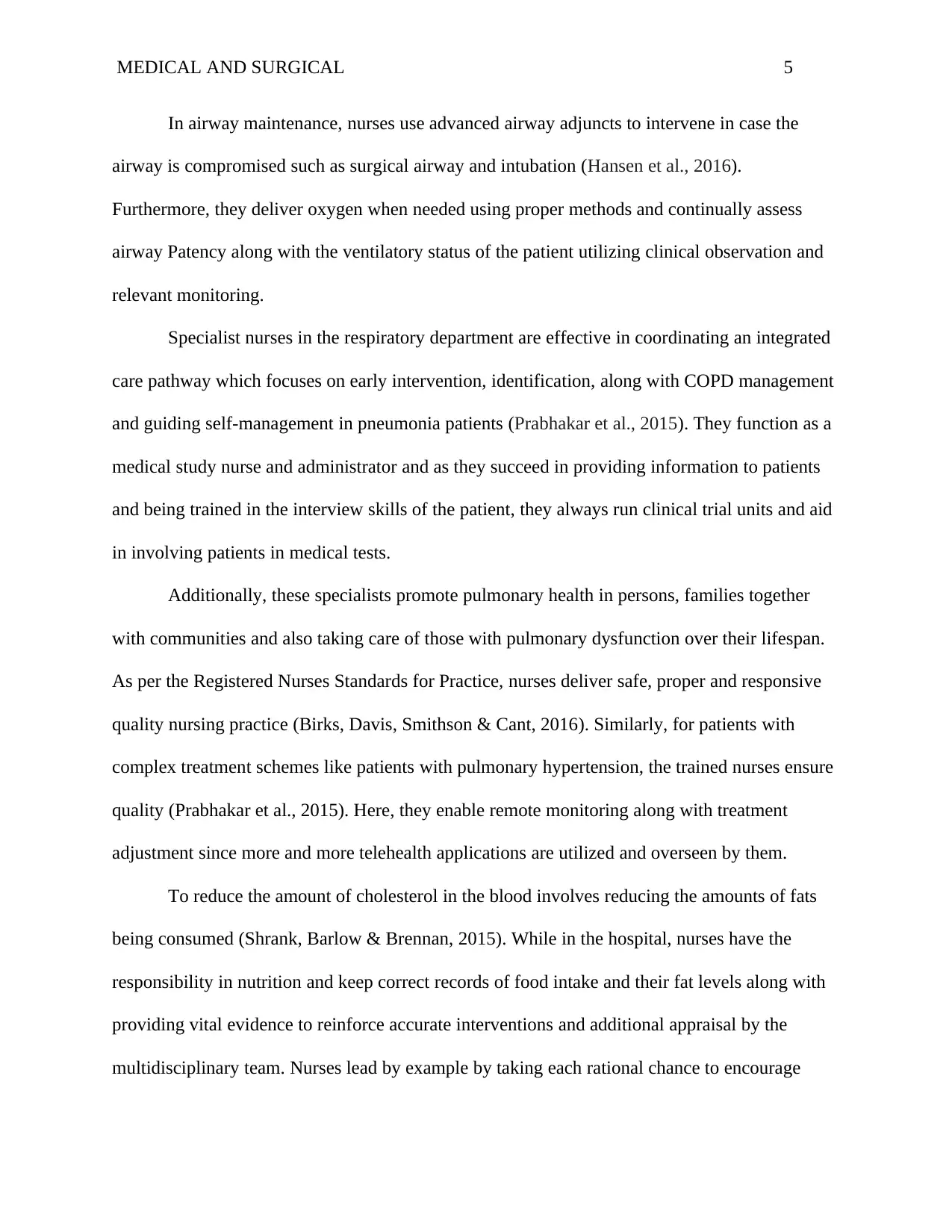
MEDICAL AND SURGICAL 5
In airway maintenance, nurses use advanced airway adjuncts to intervene in case the
airway is compromised such as surgical airway and intubation (Hansen et al., 2016).
Furthermore, they deliver oxygen when needed using proper methods and continually assess
airway Patency along with the ventilatory status of the patient utilizing clinical observation and
relevant monitoring.
Specialist nurses in the respiratory department are effective in coordinating an integrated
care pathway which focuses on early intervention, identification, along with COPD management
and guiding self-management in pneumonia patients (Prabhakar et al., 2015). They function as a
medical study nurse and administrator and as they succeed in providing information to patients
and being trained in the interview skills of the patient, they always run clinical trial units and aid
in involving patients in medical tests.
Additionally, these specialists promote pulmonary health in persons, families together
with communities and also taking care of those with pulmonary dysfunction over their lifespan.
As per the Registered Nurses Standards for Practice, nurses deliver safe, proper and responsive
quality nursing practice (Birks, Davis, Smithson & Cant, 2016). Similarly, for patients with
complex treatment schemes like patients with pulmonary hypertension, the trained nurses ensure
quality (Prabhakar et al., 2015). Here, they enable remote monitoring along with treatment
adjustment since more and more telehealth applications are utilized and overseen by them.
To reduce the amount of cholesterol in the blood involves reducing the amounts of fats
being consumed (Shrank, Barlow & Brennan, 2015). While in the hospital, nurses have the
responsibility in nutrition and keep correct records of food intake and their fat levels along with
providing vital evidence to reinforce accurate interventions and additional appraisal by the
multidisciplinary team. Nurses lead by example by taking each rational chance to encourage
In airway maintenance, nurses use advanced airway adjuncts to intervene in case the
airway is compromised such as surgical airway and intubation (Hansen et al., 2016).
Furthermore, they deliver oxygen when needed using proper methods and continually assess
airway Patency along with the ventilatory status of the patient utilizing clinical observation and
relevant monitoring.
Specialist nurses in the respiratory department are effective in coordinating an integrated
care pathway which focuses on early intervention, identification, along with COPD management
and guiding self-management in pneumonia patients (Prabhakar et al., 2015). They function as a
medical study nurse and administrator and as they succeed in providing information to patients
and being trained in the interview skills of the patient, they always run clinical trial units and aid
in involving patients in medical tests.
Additionally, these specialists promote pulmonary health in persons, families together
with communities and also taking care of those with pulmonary dysfunction over their lifespan.
As per the Registered Nurses Standards for Practice, nurses deliver safe, proper and responsive
quality nursing practice (Birks, Davis, Smithson & Cant, 2016). Similarly, for patients with
complex treatment schemes like patients with pulmonary hypertension, the trained nurses ensure
quality (Prabhakar et al., 2015). Here, they enable remote monitoring along with treatment
adjustment since more and more telehealth applications are utilized and overseen by them.
To reduce the amount of cholesterol in the blood involves reducing the amounts of fats
being consumed (Shrank, Barlow & Brennan, 2015). While in the hospital, nurses have the
responsibility in nutrition and keep correct records of food intake and their fat levels along with
providing vital evidence to reinforce accurate interventions and additional appraisal by the
multidisciplinary team. Nurses lead by example by taking each rational chance to encourage
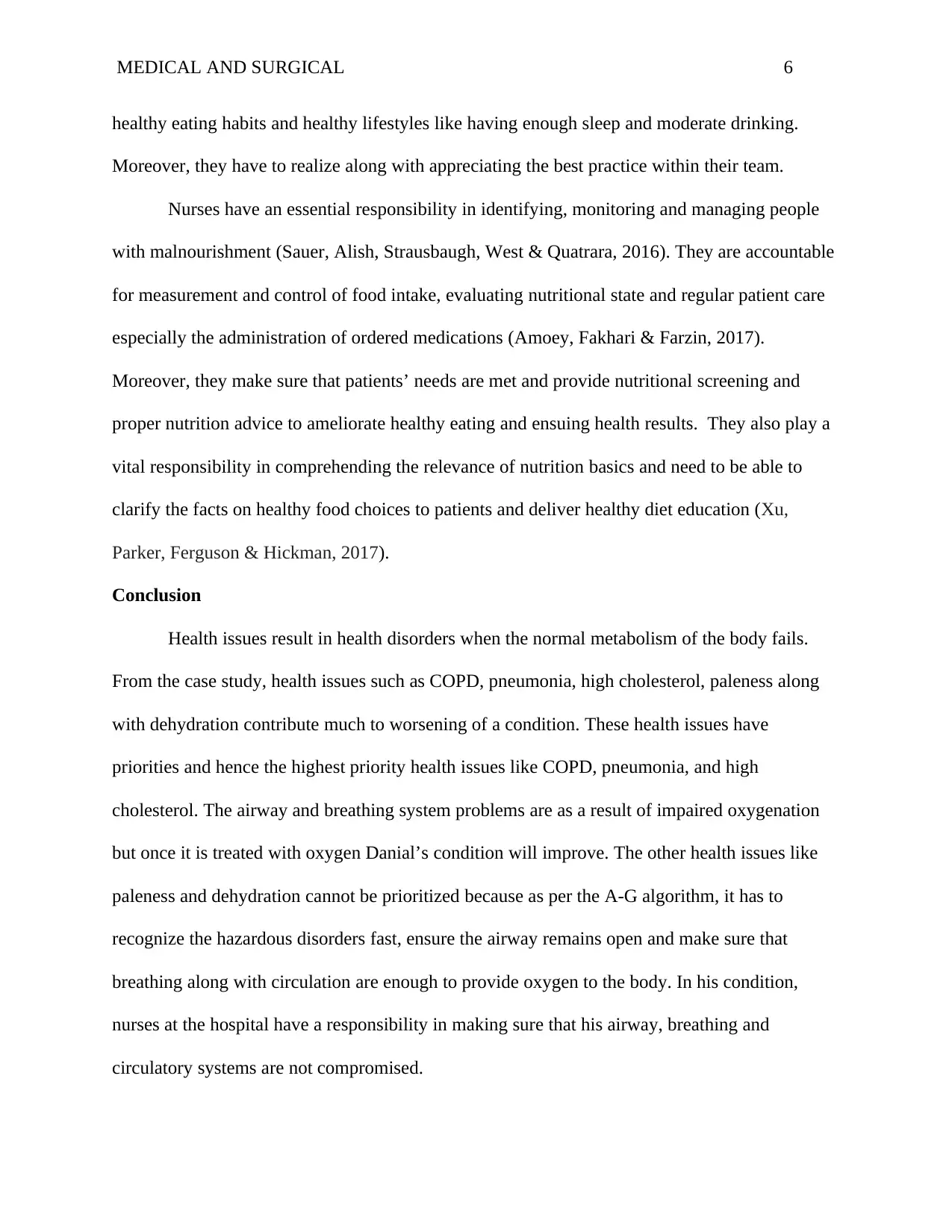
MEDICAL AND SURGICAL 6
healthy eating habits and healthy lifestyles like having enough sleep and moderate drinking.
Moreover, they have to realize along with appreciating the best practice within their team.
Nurses have an essential responsibility in identifying, monitoring and managing people
with malnourishment (Sauer, Alish, Strausbaugh, West & Quatrara, 2016). They are accountable
for measurement and control of food intake, evaluating nutritional state and regular patient care
especially the administration of ordered medications (Amoey, Fakhari & Farzin, 2017).
Moreover, they make sure that patients’ needs are met and provide nutritional screening and
proper nutrition advice to ameliorate healthy eating and ensuing health results. They also play a
vital responsibility in comprehending the relevance of nutrition basics and need to be able to
clarify the facts on healthy food choices to patients and deliver healthy diet education (Xu,
Parker, Ferguson & Hickman, 2017).
Conclusion
Health issues result in health disorders when the normal metabolism of the body fails.
From the case study, health issues such as COPD, pneumonia, high cholesterol, paleness along
with dehydration contribute much to worsening of a condition. These health issues have
priorities and hence the highest priority health issues like COPD, pneumonia, and high
cholesterol. The airway and breathing system problems are as a result of impaired oxygenation
but once it is treated with oxygen Danial’s condition will improve. The other health issues like
paleness and dehydration cannot be prioritized because as per the A-G algorithm, it has to
recognize the hazardous disorders fast, ensure the airway remains open and make sure that
breathing along with circulation are enough to provide oxygen to the body. In his condition,
nurses at the hospital have a responsibility in making sure that his airway, breathing and
circulatory systems are not compromised.
healthy eating habits and healthy lifestyles like having enough sleep and moderate drinking.
Moreover, they have to realize along with appreciating the best practice within their team.
Nurses have an essential responsibility in identifying, monitoring and managing people
with malnourishment (Sauer, Alish, Strausbaugh, West & Quatrara, 2016). They are accountable
for measurement and control of food intake, evaluating nutritional state and regular patient care
especially the administration of ordered medications (Amoey, Fakhari & Farzin, 2017).
Moreover, they make sure that patients’ needs are met and provide nutritional screening and
proper nutrition advice to ameliorate healthy eating and ensuing health results. They also play a
vital responsibility in comprehending the relevance of nutrition basics and need to be able to
clarify the facts on healthy food choices to patients and deliver healthy diet education (Xu,
Parker, Ferguson & Hickman, 2017).
Conclusion
Health issues result in health disorders when the normal metabolism of the body fails.
From the case study, health issues such as COPD, pneumonia, high cholesterol, paleness along
with dehydration contribute much to worsening of a condition. These health issues have
priorities and hence the highest priority health issues like COPD, pneumonia, and high
cholesterol. The airway and breathing system problems are as a result of impaired oxygenation
but once it is treated with oxygen Danial’s condition will improve. The other health issues like
paleness and dehydration cannot be prioritized because as per the A-G algorithm, it has to
recognize the hazardous disorders fast, ensure the airway remains open and make sure that
breathing along with circulation are enough to provide oxygen to the body. In his condition,
nurses at the hospital have a responsibility in making sure that his airway, breathing and
circulatory systems are not compromised.
⊘ This is a preview!⊘
Do you want full access?
Subscribe today to unlock all pages.

Trusted by 1+ million students worldwide
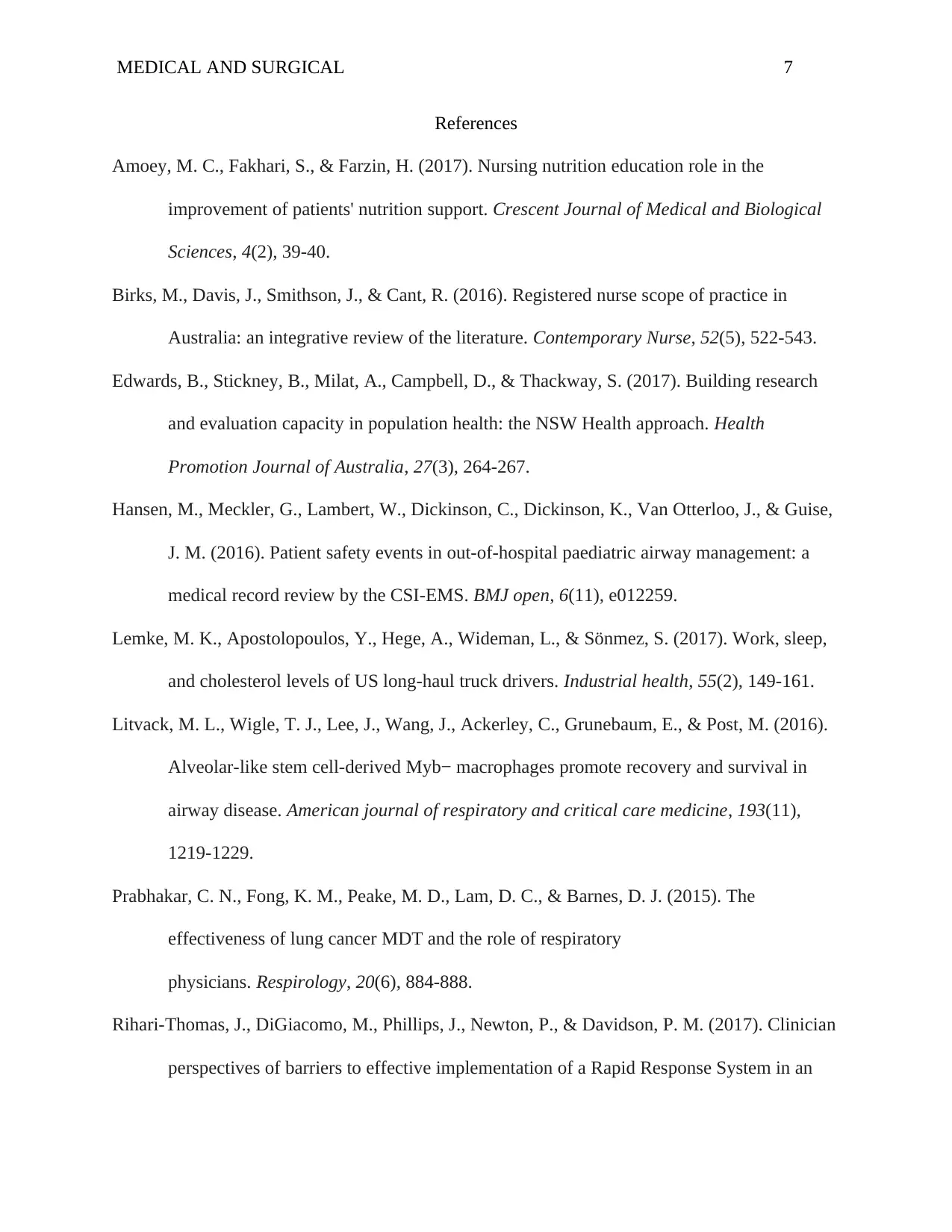
MEDICAL AND SURGICAL 7
References
Amoey, M. C., Fakhari, S., & Farzin, H. (2017). Nursing nutrition education role in the
improvement of patients' nutrition support. Crescent Journal of Medical and Biological
Sciences, 4(2), 39-40.
Birks, M., Davis, J., Smithson, J., & Cant, R. (2016). Registered nurse scope of practice in
Australia: an integrative review of the literature. Contemporary Nurse, 52(5), 522-543.
Edwards, B., Stickney, B., Milat, A., Campbell, D., & Thackway, S. (2017). Building research
and evaluation capacity in population health: the NSW Health approach. Health
Promotion Journal of Australia, 27(3), 264-267.
Hansen, M., Meckler, G., Lambert, W., Dickinson, C., Dickinson, K., Van Otterloo, J., & Guise,
J. M. (2016). Patient safety events in out-of-hospital paediatric airway management: a
medical record review by the CSI-EMS. BMJ open, 6(11), e012259.
Lemke, M. K., Apostolopoulos, Y., Hege, A., Wideman, L., & Sönmez, S. (2017). Work, sleep,
and cholesterol levels of US long-haul truck drivers. Industrial health, 55(2), 149-161.
Litvack, M. L., Wigle, T. J., Lee, J., Wang, J., Ackerley, C., Grunebaum, E., & Post, M. (2016).
Alveolar-like stem cell-derived Myb− macrophages promote recovery and survival in
airway disease. American journal of respiratory and critical care medicine, 193(11),
1219-1229.
Prabhakar, C. N., Fong, K. M., Peake, M. D., Lam, D. C., & Barnes, D. J. (2015). The
effectiveness of lung cancer MDT and the role of respiratory
physicians. Respirology, 20(6), 884-888.
Rihari-Thomas, J., DiGiacomo, M., Phillips, J., Newton, P., & Davidson, P. M. (2017). Clinician
perspectives of barriers to effective implementation of a Rapid Response System in an
References
Amoey, M. C., Fakhari, S., & Farzin, H. (2017). Nursing nutrition education role in the
improvement of patients' nutrition support. Crescent Journal of Medical and Biological
Sciences, 4(2), 39-40.
Birks, M., Davis, J., Smithson, J., & Cant, R. (2016). Registered nurse scope of practice in
Australia: an integrative review of the literature. Contemporary Nurse, 52(5), 522-543.
Edwards, B., Stickney, B., Milat, A., Campbell, D., & Thackway, S. (2017). Building research
and evaluation capacity in population health: the NSW Health approach. Health
Promotion Journal of Australia, 27(3), 264-267.
Hansen, M., Meckler, G., Lambert, W., Dickinson, C., Dickinson, K., Van Otterloo, J., & Guise,
J. M. (2016). Patient safety events in out-of-hospital paediatric airway management: a
medical record review by the CSI-EMS. BMJ open, 6(11), e012259.
Lemke, M. K., Apostolopoulos, Y., Hege, A., Wideman, L., & Sönmez, S. (2017). Work, sleep,
and cholesterol levels of US long-haul truck drivers. Industrial health, 55(2), 149-161.
Litvack, M. L., Wigle, T. J., Lee, J., Wang, J., Ackerley, C., Grunebaum, E., & Post, M. (2016).
Alveolar-like stem cell-derived Myb− macrophages promote recovery and survival in
airway disease. American journal of respiratory and critical care medicine, 193(11),
1219-1229.
Prabhakar, C. N., Fong, K. M., Peake, M. D., Lam, D. C., & Barnes, D. J. (2015). The
effectiveness of lung cancer MDT and the role of respiratory
physicians. Respirology, 20(6), 884-888.
Rihari-Thomas, J., DiGiacomo, M., Phillips, J., Newton, P., & Davidson, P. M. (2017). Clinician
perspectives of barriers to effective implementation of a Rapid Response System in an
Paraphrase This Document
Need a fresh take? Get an instant paraphrase of this document with our AI Paraphraser
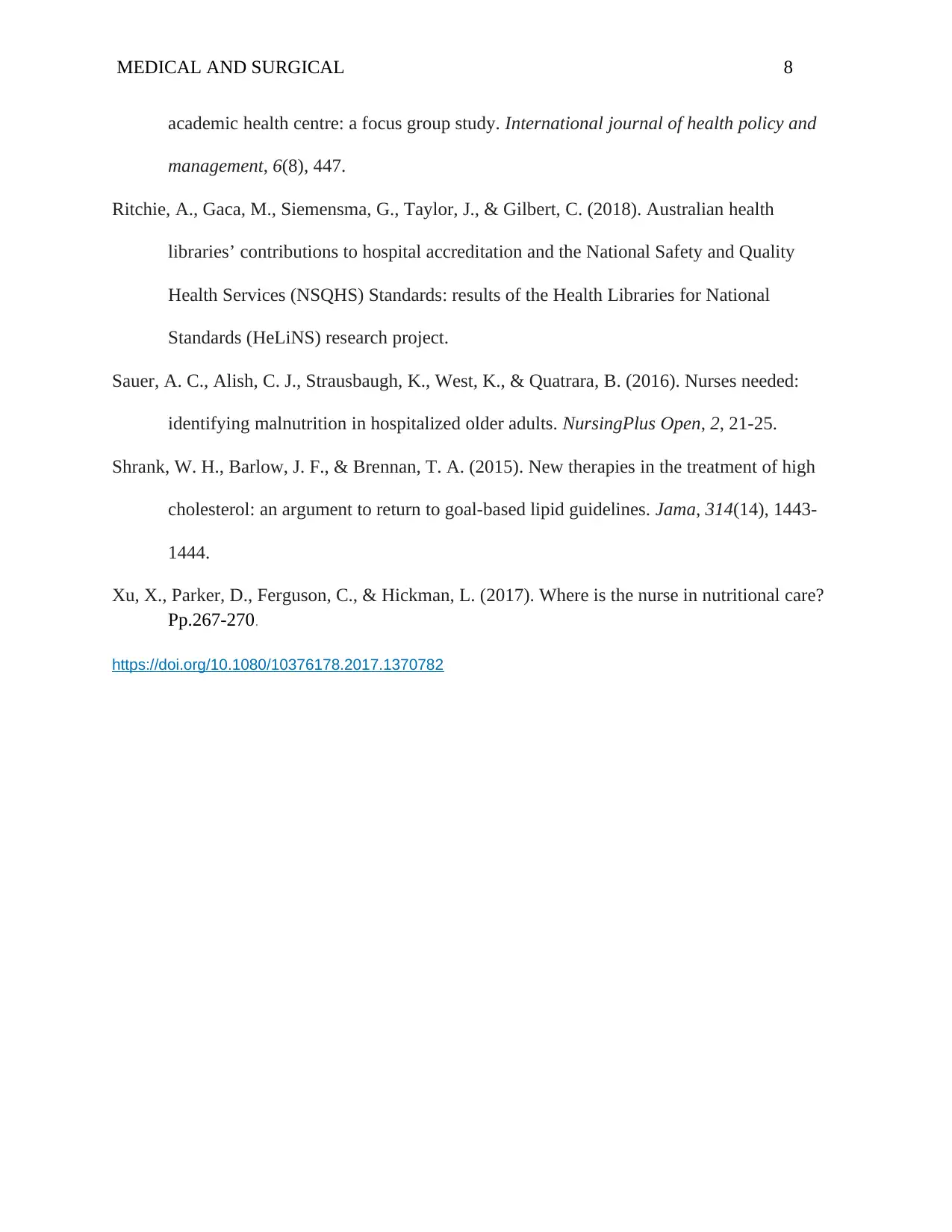
MEDICAL AND SURGICAL 8
academic health centre: a focus group study. International journal of health policy and
management, 6(8), 447.
Ritchie, A., Gaca, M., Siemensma, G., Taylor, J., & Gilbert, C. (2018). Australian health
libraries’ contributions to hospital accreditation and the National Safety and Quality
Health Services (NSQHS) Standards: results of the Health Libraries for National
Standards (HeLiNS) research project.
Sauer, A. C., Alish, C. J., Strausbaugh, K., West, K., & Quatrara, B. (2016). Nurses needed:
identifying malnutrition in hospitalized older adults. NursingPlus Open, 2, 21-25.
Shrank, W. H., Barlow, J. F., & Brennan, T. A. (2015). New therapies in the treatment of high
cholesterol: an argument to return to goal-based lipid guidelines. Jama, 314(14), 1443-
1444.
Xu, X., Parker, D., Ferguson, C., & Hickman, L. (2017). Where is the nurse in nutritional care?
Pp.267-270.
https://doi.org/10.1080/10376178.2017.1370782
academic health centre: a focus group study. International journal of health policy and
management, 6(8), 447.
Ritchie, A., Gaca, M., Siemensma, G., Taylor, J., & Gilbert, C. (2018). Australian health
libraries’ contributions to hospital accreditation and the National Safety and Quality
Health Services (NSQHS) Standards: results of the Health Libraries for National
Standards (HeLiNS) research project.
Sauer, A. C., Alish, C. J., Strausbaugh, K., West, K., & Quatrara, B. (2016). Nurses needed:
identifying malnutrition in hospitalized older adults. NursingPlus Open, 2, 21-25.
Shrank, W. H., Barlow, J. F., & Brennan, T. A. (2015). New therapies in the treatment of high
cholesterol: an argument to return to goal-based lipid guidelines. Jama, 314(14), 1443-
1444.
Xu, X., Parker, D., Ferguson, C., & Hickman, L. (2017). Where is the nurse in nutritional care?
Pp.267-270.
https://doi.org/10.1080/10376178.2017.1370782
1 out of 8
Related Documents
Your All-in-One AI-Powered Toolkit for Academic Success.
+13062052269
info@desklib.com
Available 24*7 on WhatsApp / Email
![[object Object]](/_next/static/media/star-bottom.7253800d.svg)
Unlock your academic potential
Copyright © 2020–2025 A2Z Services. All Rights Reserved. Developed and managed by ZUCOL.





